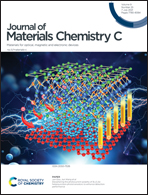Microstructure and colossal permittivity of CaTiO3 ceramics covered with nano-sized CuO and TiO2 by the hydrothermal method
Abstract
In this work, CaTiO3-based particles covered with nano-sized CuO and TiO2 particles were obtained by the hydrothermal method (CuO/CaTiO3 (molar ratio) = 0.2 and TiO2/CaTiO3 (molar ratio) = 0, 0.05, 0.10, 0.15, 0.20, 0.25, and 0.30, respectively). The dense ceramics with a colossal dielectric constant at room temperature (εr > 1.2 × 105 at 20 Hz, εr > 7 × 103 at 1 kHz) and good temperature stability was obtained by microwave sintering at 1400 °C. The crystal structure, morphology, dielectric properties, impedance, and oxidation state of the ceramics were systematically analyzed. According to the results, the weak-trapped electrons are derived from defects  and
and  in the semiconducting CaCu3Ti4O12 regions. A large amount of nano-sized CuO and TiO2 covered on the surface of CaTiO3 blocks the transfer of substances between grains, resulting in small ceramic grains. Simultaneously, the synthesized CaCu3Ti4O12 and CaTiO3 form a structure similar to nano-scale barrier layer capacitance (NBLC), and it can be proved by impedance analysis. The results show that a large number of weak-trapped electrons, smaller crystal grains and a structure similar to NBLC are the possible main reasons for the colossal permittivity.
in the semiconducting CaCu3Ti4O12 regions. A large amount of nano-sized CuO and TiO2 covered on the surface of CaTiO3 blocks the transfer of substances between grains, resulting in small ceramic grains. Simultaneously, the synthesized CaCu3Ti4O12 and CaTiO3 form a structure similar to nano-scale barrier layer capacitance (NBLC), and it can be proved by impedance analysis. The results show that a large number of weak-trapped electrons, smaller crystal grains and a structure similar to NBLC are the possible main reasons for the colossal permittivity.



 Please wait while we load your content...
Please wait while we load your content...